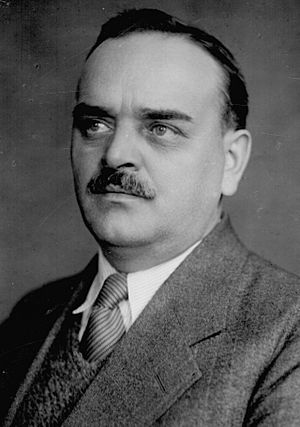Nikolai Shvernik facts for kids
Quick facts for kids
Nikolai Shvernik
Николай Шверник |
|
|---|---|

Shvernik in 1938
|
|
| Head of State of Soviet Union | |
| In office 19 March 1946 – 15 March 1953 |
|
| General Secretary | Joseph Stalin |
| Preceded by | Mikhail Kalinin |
| Succeeded by | Kliment Voroshilov |
| Chairman of the Presidium of the Supreme Soviet of the Russian SFSR | |
| In office 4 March 1944 – 25 June 1946 |
|
| Preceded by | Aleksei Badayev Ivan Vlasov (Acting) |
| Succeeded by | Ivan Vlasov |
| Full member of the 20th, 22nd Presidium | |
| In office 29 June 1957 – 8 April 1966 |
|
| In office 16 October 1952 – 5 March 1953 |
|
| Candidate member of the 18th, 19th Presidium | |
| In office 5 March 1953 – 29 June 1957 |
|
| Full member of the 14th, 16th, 17th Orgburo | |
| In office 22 March 1939 – 16 October 1952 |
|
| In office 9 April 1926 – 16 April 1927 |
|
| Full member of the 16th Secretariat | |
| In office 13 July 1930 – 10 February 1934 |
|
| Candidate member of the 14th Secretariat | |
| In office 9 April 1926 – 16 April 1927 |
|
| Personal details | |
| Born | 7 May 1888 St. Petersburg, Russian Empire |
| Died | 24 December 1970 (aged 82) Moscow, Russian SFSR, Soviet Union |
| Resting place | Kremlin Wall Necropolis, Moscow |
| Nationality | Soviet |
| Political party | RSDLP (Bolsheviks) (1905–1918) Russian Communist Party (1918–1966) |
| Spouse | Mariya Fedorovna Ulazovskaya |
Nikolai Mikhailovich Shvernik (Russian: Никола́й Миха́йлович Шве́рник, May 7, 1888 – December 24, 1970) was an important Soviet politician. He served as the Chairman of the Presidium of the Supreme Soviet from 1946 to 1953. This role made him the official head of state of the Soviet Union. However, during this time, Joseph Stalin held more actual power as the head of the government.
Contents
Early Life and Political Beginnings
Nikolai Shvernik was born in 1888 in St. Petersburg, which was then part of the Russian Empire. His family was working-class; his father was a retired soldier who worked in factories, and his mother was a weaver.
Shvernik started working in factories as a turner. In 1905, he joined the Bolsheviks, a political group that later became the main part of the Communist Party. After the February Revolution in 1917, he became a leader in a factory council and a city council in Samara.
During the Russian Civil War, he worked as a political officer in the Red Army. From 1921 to 1923, he was involved in trade unions, which are groups that protect workers' rights.
Rising Through the Ranks
In 1923, Shvernik began working for a government department led by Joseph Stalin. He was a strong supporter of Stalin during the political struggles of the 1920s. In 1925, he was chosen by the Central Committee to lead the party in Leningrad (now St. Petersburg). This was a key position.
Shvernik became a full member of the Central Committee in December 1925 and remained so for 45 years. In 1926, he joined the Secretariat, a powerful group of four secretaries led by Stalin. He continued to show strong loyalty to Stalin.
In the late 1920s, when there were food shortages, Shvernik was sent to the Urals region. His job was to help collect grain from farmers. He also supported Stalin's plan to rapidly industrialize the Soviet economy.
Leading Trade Unions and Wartime Efforts
In 1929, Shvernik was called back to Moscow. He became the chairman of the Metallurgist Trade Union. From 1930 to 1944, he served as the first secretary of the All-Union Central Council of Trade Unions. This made him a very important figure in the Soviet labor movement.
During the Second World War, Shvernik played a crucial role. He was in charge of moving Soviet factories and industries away from the advancing German army (the Wehrmacht). This helped the Soviet Union continue to produce weapons and supplies for the war effort.
From 1938 to 1946, he was the Chairman of the Soviet of Nationalities, one of the two chambers of the Soviet parliament. He also served as Chairman of the Presidium of the Supreme Soviet of the Russian SFSR from 1944 to 1946.
Head of State and Later Years
In 1946, Nikolai Shvernik became the Chairman of the Presidium of the Supreme Soviet of the USSR. This was the highest official position in the Soviet Union, making him the head of state. He took over from Mikhail Kalinin. He became a full member of the Politburo in 1952.
After Stalin's death in March 1953, Shvernik was deeply affected. He was replaced as Chairman of the Presidium of the Supreme Soviet by Kliment Voroshilov and returned to his role as chairman of the All-Union Central Council of Trade Unions.
Despite his long loyalty to Stalin, Shvernik supported Nikita Khrushchev after Khrushchev gave his "Secret Speech" in 1956. This speech criticized many of Stalin's actions. Shvernik was then appointed Chairman of the Central Control Commission. In this role, he helped to clear the names of many people who had been wrongly punished during Stalin's time.
In July 1957, Shvernik once again became a full member of the Presidium. He remained in this important position until he retired in 1966.
Nikolai Shvernik passed away on December 24, 1970, in Moscow at the age of 82. His ashes were placed in an urn in the Kremlin Wall Necropolis, a special burial place for important Soviet figures.
See also

- In Spanish: Nikolái Shvérnik para niños

